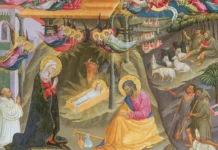Wishing to take a decisive step in his spiritual life, Dr. Plinio decided to make a novena to St. Thérèse of the Child Jesus. She heeded him by leading him to the book which would be the basis for his Marian spirituality: the “Treatise of True Devotion to Mary”.

During his final year of Law School, Plinio occupied much of his time with readings on subjects pertaining to Catholic doctrine, from which he reaped considerable benefits.
He began these studies with the famous encyclicals of Leo XIII and, shortly afterwards, took an interest in the works of St. Thomas Aquinas, St. Augustine and their commentators. Amongst more recent Catholic writers were Joseph de Maistre, De Bonald, Blanc de Saint Bonnet, Louis Veuillot, Balmes, Donoso Cortés, Nocedal, Cathrein and Solaro di Santa Margherita, highly praised for their orthodoxy, who provided him with abundant material, especially those who expounded on pontifical documents.
One book, Saggio di diritto naturale by Taparelli D’Azeglio, the famous Jesuit lawyer, particularly delighted him on account of the clarity and logic with which it dealt with the principles of natural law.
The need to form comprehensive doctrinal perspectives
Over the years, the observation of various aspects of the world around him, as well as the analysis of innumerable past events, had come together like a true work of historical and doctrinal synthesis, which he had perfected to the measure of his maturity in each successive period of his life. In this compilation, the teachings of the Holy Church and the impressions elicited by religious ceremonies or by the atmosphere of sacred edifices clearly played a central role.
Now, having crossed the threshold of twenty years of age, a problem presented itself to him with entire precision: “To what extent were the elements of this synthesis effectively in accordance with the Church, and more specifically with the Chair of Peter, to which I bore limitless veneration, love and obedience? This question, of fundamental importance, opened up for me the period of methodical doctrinal studies for which my speculations as a boy had prepared me.”
So, feeling the need to formulate comprehensive general perspectives regarding the themes on which he had meditated since childhood, Plinio decided to deepen his knowledge with the goal of consolidating three things: first, various intuitions not yet fully explained, which he now wished to submit to the scrutiny of reason under the light of doctrine; second, those conclusions that he had already reached by means of reflection; and last, the teaching of the Holy Church drawn from the Sacred Magisterium and from the aforementioned authors, with which Plinio wished to harmonize all of his ideas, convictions and preferences.
Upon perceiving that these authors – men of eminent intelligence – had arrived at the same conclusions as he had on a number of points, he was reassured in his certainties and felt deep interior tranquillity. Furthermore, he understood that there was perfect consonance between their writings and that which was still only implicit in his mind.
Emphatically agreeing with everything he read, he was thrilled to find that these theses could be explained with such cogency: “The authors demonstrated that there is a tangible order of things which, through a certain gift of God, I was more able to intuit than to prove. This produced in me an admiration for the scholars who had described that order.” However, it was the Church that he venerated in a special way, delighting above all in its wisdom, which had inspired them.

Study and mystical graces
The beauty of those ideas elicited in him a sentiment of piety, of the kind aroused by a beautiful statue or experienced during prayer. On another occasion, he commented that the only reason he did not kiss the book was because it seemed to him a somewhat romantic gesture, and he could not yield to romanticism even when alone in a room. And with respect to the graces received at that time, he explained: “Nowadays, I am led to ask myself if there were not some additional mystical element to the way in which that notion of order presented itself to my spirit.”
The phenomenon which occurred within Plinio during that time was mystical beyond doubt, even in connection with his reading of the work of Taparelli D’Azeglio. Upon encountering certain citations in the works of St. Thomas Aquinas, and awestruck in face of that sublime manifestation of logic, he clearly discerned the mentality of the Angelic Doctor, so vividly that he assimilated something of the latter’s intelligence and method of thought, through a kind of “inhalation of the criteriology in him.”
Dr. Plinio’s own recollections in this respect are detailed and convincing: without having received a vision or revelation, but having been endowed since childhood with the gift of discernment of spirits, he acquired an accentuated capacity for understanding the Thomistic method of which he was to make use throughout his life, since it had been granted to him definitively.
Nevertheless, in order to better understand the significance of what happened on that occasion, there could be nothing more appropriate than to repeat the illustration he used: “I have found a perfect image: someone is aboard a ship with a friend who, having a pair of binoculars, describes a series of things which the first does not see. At a point, the friend passes the binoculars to the other, who begins to see what he had not seen before, ‘appropriating’ another’s vision for himself. It was the same with St. Thomas: it was as if something in his mind functioned like a pair of binoculars, which I placed in my mind. And this was not just fleeting a glimmer, but even today I see his mentality and, through it, I understand the world better. If I have the binoculars in hand, I can keep them in front of my eyes for fifty years…”
Let us recall that something similar had already occurred when the young Plinio, then a student at St. Louis College, had unexpectedly felt during class time that he received a participation in the mentality of St. Ignatius Loyola. However, according to his own words, while the logic of St. Ignatius seemed to him to be made of fire and effervescence, that of St. Thomas was so serene that it seemed to be made of crystal.
The desire to grow in holiness
It was also in that last year of Law School that an episode occurred which would have consequences of fundamental importance for Plinio’s spiritual formation and mark his life deeply.
He had already made the resolution to dedicate his life to the service of the Church and, moreover, not to marry; nevertheless, analysing himself and recognizing how much progress he had made, to the point of finding himself at a peak in his interior life, he felt unsatisfied. He feared that he had halted on the way of perfection and he desired to move to a higher level, committing himself even more deeply to devotion to Our Lady. In a word, he wanted to be more holy, but he did not know what to do in order to achieve this.
He thought that such a special grace might visit him through some good book of piety. But where to find one? It should be noted that he had difficulty in adapting to a certain cloying and sentimental style of religious literature, common at that time. He wanted serious and substantial reading in which emotion would occupy a secondary role and the better part would be dedicated to what was most important – reason illuminated by faith.

Two petitions to St. Thérèse
Plinio had already acquired the habit of praying to St. Thérèse of the Child Jesus, whose recent canonization had caused an extraordinary upsurge of fervour worldwide. And, among the many benefits which his reading of Story of a Soul had brought him, he had been especially impressed with the appendix of the work, which contained a list of some of the countless favours received by the faithful through her mediation. Consequently, having in mind the new level he desired to reach in the ways of sanctity, he decided to begin a novena to St. Thérèse to which he had been recently introduced and which had touched him deeply. He would ask her intercession to obtain two graces for which he felt great need.
The first was that she might clearly indicate for him the means to make dynamic progress in devotion to Our Lady, taking a decisive and fundamental step in that direction, and that, to this end, she would help him to find the life-changing book that he was seeking.
The second intention was entirely different: Plinio was in a difficult financial situation, whose most painful aspect was the uncertainty in which it placed the future of his mother, Dona Lucilia. For that reason, having heard that a lottery was being held in São Paulo offering a large cash prize, sufficient for the upkeep of an affluent family, he also asked St. Thérèse the favour of winning it. He naturally was not seeking to strike it rich but rather to maintain a comfortable and stable social position, free of financial and professional concerns, so as to be able to dedicate himself entirely to the apostolate.
So he bought the lottery ticket and started to pray for those intentions. Curiously, he thought that the most important of the two petitions was that of obtaining the money, for a simple reason: it was the one which seemed least likely to be fulfilled, since Catholic bookstores were abounding in good books, whereas it was unheard of that a young man of his age in São Paulo had come into wealth by a lottery prize.
“The book of my life”
The novena was finishing when Plinio, upon leaving the Church of the Immaculate Heart of Mary where he had received Communion, decided to visit the Ave Maria bookstore belonging to the Claretian priests, located in the back of the same church, with the intention of finding some spiritual reading that would be to his liking. Browsing through some books, his attention was drawn to two in particular. One of them, whose title he could not remember later, was thicker and of an inviting appearance; the other was a poket-sized, well-bound edition, engraved in black and red: it was the Traité de la vraie dévotion à la Sainte Vierge, by an author unknown to him, despite his being Blessed: Le Bienheureux Louis-Marie Grignion de Montfort.
He felt inclined to buy the first, but his hesitation was of short duration: he ended up choosing the Treatise on True Devotion to Mary for its appearance and presentation, because it was written in French and, above all, because it dealt with Our Lady. He asked how much it cost and, after finding that the little book was inexpensive and within the scope of his limited resources, he had it wrapped, paid for it and took it home. Later recounting the episode, he would affirm: “I did not realize that St. Thérèse was guiding my hand.”
The next morning, during his usual meditation time, Plinio opened the Treatise without much hope, for he had no assurance that this was the book obtained through St. Thérèse.
According to his custom, he began reading from a random page, from the middle until the end, and only then would he read the beginning. What was the reason for this habit? He explained it in these terms: it seemed to him that books became more interesting when the reader had something to figure out, not only with respect to what the author was saying, but also regarding his intentions. So, reading from halfway through, he could conjecture the nature of the opening, which added a certain touch of novelty that he found agreeable.

However, with the Treatise on True Devotion, Plinio stopped, enchanted, after reading one or two pages and thought: “No, this book cannot be read in such a way. It has to be from the beginning, because it is of a high calibre! It is exactly what I was seeking!” As he continued reading, his enthusiasm mounted and without missing a word, “from acclamation to acclamation,” he came to the conclusion that St. Louis de Montfort’s work was incomparable, portentous and founded on the best Theology; it delved deeply into the doctrine surrounding Mary Most Holy, so as to provide a sublime understanding of her role in the order of the universe.
As Dr. Plinio would recall: “While reading it, I would pause at times and say: ‘It seems as if this man is speaking! He died centuries ago, but I seem to feel the impulse, the impetus of his soul in what he says here!’” As he advanced, his soul resonated in euphoric consonance with what he learned. He had never imagined that a book could exercise such an effect on someone as did that one on him. And he thought: “I have found the book of my life!”
A study full of enthusiasm
Over the subsequent days, his reading of the Treatise became a serious and in-depth study. Plinio pondered and analysed each section so as to gain a complete overview of the material, taking notes and summarizing it, a task facilitated by the habits he had acquired at Law School. And so effectively did he assimilate what he read that he ended up composing a litany of considerable length for his personal use, set down on proximately ten small pages, some of them handwritten, with all of the titles and invocations of Our Lady mentioned in the work, and translated by him into Portuguese.
Henceforth, all of his commentaries upon that which he had learned on this occasion of the Marian spirituality of St. Louis-Marie Grignion de Montfort would proceed ex abundantia cordis, the fruit of application of the intellect replete with love. He perceived that the book could give to those who meditated upon it an exact idea of who the Blessed Virgin Mary is, and the stature of her ineffable grandeur, her goodness and her mercy, as well as of the value of her intercession. ◊
Taken, with adaptations, from:
“O dom de sabedoria na mente, vida e obra de Plinio Corrêa de Oliveira”
[The Gift of Wisdom in the Mind, Life
and Work of Plinio Corrêa de Oliveira]. Città del Vaticano-São Paulo: LEV; Lumen Sapientiæ, 2016, v.II, p.159-169







